Barmer basin
| Petroleum Systems Analysis—Case Studies | |
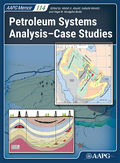
| |
| Series | Memoir |
|---|---|
| Chapter | Hydrocarbon generation and migration modeling in the Barmer Basin of Western Rajasthan, India: Lessons for Exploration in Rift Basins with Late-State Inversion, Uplift, and Tilting |
| Author | Bodapati S. Naidu, V. R. Sunder, Vachaspati Kothari, Pinak Mohapatra, Stuart D. Burley, John Dolson, Paul Farrimond |
| Link | Web page |
| Store | AAPG Store |
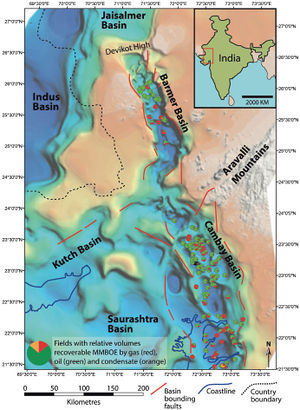
Introduction
The Barmer Basin of northwestern Rajasthan, India (Figure 1), contains some 7 BBOE (billion barrels oil equivalent) of proven gross in place resources standard tank oil initially in place (STOIIP) in 38 discovered fields and over 3 BBOE of prospective resources in un-drilled leads and prospects. It is a relatively new hydrocarbon province successfully explored only over the last 20 years (Sisodia and Singh, 2000[2]; Compton, 2009[3]; Dolson et al., 2015[1]). Sediment thickness exceeds 6 km (4 mi) in the main depocenters, but only the main structures in the shallowest 4 km (2.5 mi) of the basin have so far been drilled. The basin is now penetrated by almost 300 exploration and appraisal wells with a success rate of over 50%. Despite this exploration activity, the Barmer Basin remains a relatively underexplored province, certainly when compared with the mature Cambay Basin immediately to the south (Biswas, 1987[4]; Banerjee and Rao, 1993[5]; Banerjee et al., 2002[6]; Figure 1). Significant exploration potential remains in deeper structural plays and in post-rift stratigraphic traps (Kothari et al., 2015[7]).
An extensive database on source rock properties, heat flow, reservoir types, and seal rock properties has been collected from exploration and appraisal wells together with data from scattered outcrops around the basin flanks and along the northern, uplifted margin of the basin. A summary of the current understanding of the petroleum geology of the basin is given in Dolson et al. (2015[1]), while Farrimond et al. (2015)[8] detail the aspects of the main source rocks and their properties. The full paper associated with this Wiki article describes the construction of, and simulation results from, a pseudo-3-D petroleum system model calibrated to known hydrocarbon discoveries and shows. The model has been used to investigate the distribution of discovered oil and gas fields in the Barmer Basin, the evolution of migration pathways, and the hydrocarbon charge history of the basin as it developed.
Petroleum Geology
The Barmer Basin is a long (200 km [125 mi]) and narrow (<40 km [<25 mi]) asymmetric rift that extends broadly north-south in the Thar Desert of western Rajasthan, in northwest India (Figure 1). The basin connects to the north across the buried Devikot High (Siddique, 1963[9]) into the Jaisalmer Basin and to the south to the better-known Cambay Basin via the Sanchor sub-Basin (Kaila et al., 1990[10]; Bladon et al., 2015[11]; Dolson et al., 2015[1]). Both of these southerly basins are structurally related and comparable to the Barmer Basin in terms of being formed as early Cretaceous to Paleogene rifts, the former of which contains prolific hydrocarbon resources in a sequence of up to 4 km (2 mi) of Paleocene sediments (Biswas, 1982[12], 1987; Banerjee and Rao, 1993[5]; Gombos et al., 1995[13]). Recent studies indicate that the Barmer Basin is underlain by a poorly known earlier rift of probable Jurassic and certainly Cretaceous age (Bladon et al., 2015[11], 2015[14]; Dolson et al., 2015[1]), which most likely connected to the marine Mesozoic sequences of the Jaisalmer Basin to the north (Singh et al., 2005[15]) and possibly to those of the Kutch and Saurasthra basins to the west (see Figure 1). This deeper Mesozoic basin remains relatively poorly known and underexplored.
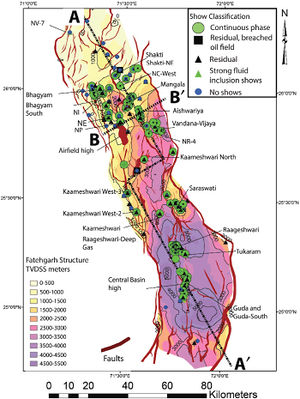
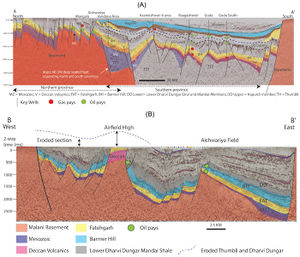
Structurally, the Barmer Basin is a typical intracontinental failed rift, bounded by normal extensional faults that display both north-northwest–south-southeast and north-northeast–south-southwest orientations (Figures 2 and 3). The basin is distinctly asymmetric in cross-section, with a regional dip to the east in the northern part of the basin, which flips to the west in the southern part. Fault-bounded horsts and ridges typically have a pronounced north–south elongation. Half-graben structures dominate, with deep synrift basins formed adjacent to footwall highs, the latter with evidence of crestal collapse and thinning of synrift stratigraphies onto the fault block highs indicative of significant initial rift topography. The presence of both hard- and soft linkages between faults is indicative of a long history of fault evolution in the basin. Older, isolated north-northwest fault segments are linked via younger north-northeast striking faults to form an extensive, through-going fault system. Individual faults connected as a result of fault-tip propagation, overstep, and subsequent breach of the intervening relay ramps (Bladon et al., 2014[16], 2015[11], 2015[14]). The resulting fault network provides fluid migration pathway linkages across long distances and vertically across thick shale sequences between otherwise isolated carrier beds and reservoirs.
The basin is shallowest in the north with pre and synrift sequences exposed at the surface, whereas the deeper, southern part of the basin has continued to undergo burial to the present day (Figure 3). The shallow northern end of the basin is underlain by a large basement high where large rift blocks form traps such as those at the Mangala, Aishwariya, and Bhagyam fields (Figure 2), and the main reservoir formations occur at depths of less than ∼ 1 km (∼0.6 mi) present day (Figure 3). North of these fields’ top seals are commonly absent in the basin with the main reservoirs being close to or exposed at the surface and have been so since the Miocene. The post-Miocene burial history of this northern part of the basin is constrained from vitrinite reflectance (VR) and apatite fission track analysis (AFTA) studies and is known to involve widespread differential uplift, tilting, and erosion. Although this uplift was centered on the northern part of the basin, amounts of uplift vary between individual fault blocks, creating complex fault block geometries that appear to increase in throw amount to the western side of the northern basin, where up to ∼1200 m (∼4000 ft) of erosion are recorded. Uplift and tilting has been a major driver of spillage and re-migration of hydrocarbons with vertical faults providing fluid migration routes. The basin deepens dramatically to the south, and a more complete post-Miocene succession is preserved, although broad inversion structures are still developed. The rapid deepening to the south coincides with a faulted basement hinge zone that controls the younger regional tilting in the basin and may represent a cross-rift transform fault system.
Synrift depositional packages thicken into the hanging walls of major synrift extensional faults. The juxtaposition of prerift and synrift reservoirs in the footwalls of major rift margin faults against thick synrift shales and source rock sediments of the hangingwalls confirms that fault activity was contemporaneous with deposition of the basin fill and enables direct, highly efficient migration of hydrocarbons from mature downthrown source rocks into carrier beds and traps.
Deep-seated extensional faults with a north-northwest–south-southeast orientation are rooted in the basement and extend upward to the early synrift sediment packages, providing potential fluid migration routes. These are often repeatedly reactivated by the north-northeast–south-southwest faults that extend through the synrift sequences, enabling early-generated hydrocarbons to extensively charge synrift sequences. However, these deep-seated faults do not cut the post-rift sequence, which remains largely isolated from the older sediment sequences.
Strikingly different and much younger north–south-oriented faults occur along the western side of the basin (Figure 2) forming the linear Airfield High (Dolson et al., 2015[1]), a structural feature bounded by steep faults that are predominantly strike-slip in nature (see Figure 2B). These faults extend further south into the basin where they connect with the Central Basin High. They are near vertical and in many cases can be seen in seismic sections to reach the surface, folding and faulting the youngest strata in the basin and creating flower-type structures. Although there is no surface expression of these faults, they are considered to have propagated southward in response to the ongoing Himalayan uplift and exhumation of the northern part of the basin. Locally, these steep faults have helped facilitate vertical hydrocarbon migration and charging of shallow structures.
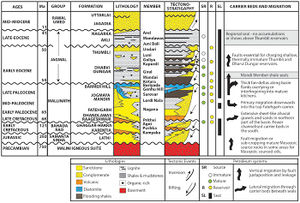
Stratigraphy
The stratigraphy of the Barmer Basin is relatively simple as illustrated in Figure 4 (modified and updated from Dolson et al., 2015[1]) and represents alternating cycles of deposition from fluvial and coaly swamps to deep water lakes into which fan deltas shed organic matter-rich debris flows and turbidites. Very minor marine influence at times of sea level highstand is indicated by the presence of short-lived communities of marine foraminifera (Nummulites), dinocysts, and ostracods (Sahni and Choudhary, 1972[17]; Tripathi et al., 2009[18]). The sedimentary sequence is dominantly Paleocene to Eocene in age and the basin fill overlies basement rocks of the Precambrian Malani Igneous Suite as well as prerift sediments of the Mesozoic fluvial Lathi and Ghaggar-Hakra formations (Compton, 2009[3]; Beaumont et al., 2015[19]; Bladon et al., 2015b[14]). The Jurassic Lathi and Cretaceous Ghaggar-Hakra formations are sand-dominated, prerift reservoirs that are well exposed around the margins of the basin and occur along the northern uplifted outcrop limit. The Ghaggar-Hakra Formation is also encountered in wells in the main fields where they host significant hydrocarbon reserves. These sand-dominated sequences, together with the synrift Fatehgarh Formation, are extensive sheet-like alluvial deposits that form well-connected carrier beds and reservoirs (Figure 4). Lake margin fan deltas and deep water turbidite systems enclosed in the Barmer Hill Formation are more restricted in their extent and less well connected, but were deposited adjacent to source rocks and so are easily charged. Although there are multiple, thick, shale sequences within the Cenozoic basin fill that form regional seals, the most significant are those of the Sarovar Member of the Barmer Hill Formation, the Mandai Member of the Dharvi Dungar Formation, and the Juni Bali Member of the Akli Formation (Figure 4). All potential source rocks younger than the Dharvi Dungar Formation are thermally immature everywhere in the basin. The shallowest oil reservoirs are, however, younger than these source rocks and are encountered in the Thumbli Formation. These reservoirs require significant fault-assisted vertical migration to receive hydrocarbon charge. There are no accumulations above the Thumbli Formation anywhere in the basin, indicating that the overlying late Eocene Akli Formation is the topmost regional seal to the petroleum system across the basin that is only breached by a few deep-seated faults, many of which extend to the surface. A major depositional hiatus of late Oligocene to early Miocene age and subsequent tilting and uplift of the northern part of the basin in the Miocene completes the basin history.
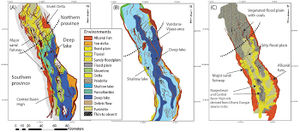
Paleogeographic maps of the most important reservoirs and source rocks are shown in Figure 5). The most prolific reservoir is the late Cretaceous to early Paleocene synrift Fatehgarh Formation. The Fatehgarh Formation forms thick, sheet-like fluvial reservoirs that are best developed in the northern part of the basin (see Figure 5A). Fatehgarh Formation fluvial facies inter-digitate with basin margin alluvial fans of the Jogmaya Mandir Formation in the north and the Dhandlawas Formation in the center and south of the basin, where they are composed of lower-quality volcaniclastic sands particularly well developed around the Central Basin High. These Fatehgarh Formation reservoirs are directly overlain by the main source rock in the basin, the lacustrine shales of the Sarovar Member of the Barmer Hill Formation (Figure 5B). Migration from these source rocks into the Fatehgarh Formation reservoirs is therefore either downward or across fault juxtapositions and highly efficient. The fan delta and lacustrine turbidite sands of the Barmer Hill Formation are easily charged with hydrocarbons as they interdigitate with and are enclosed within the source rock. The Barmer Hill Formation also contains widespread diatomite deposits of the Bariyada Member (see Figure 4) that are intimately interbedded with the source rocks, forming a significant, laterally extensive but low permeability reservoir (Chowdhury et al., 2011[20]).
The overlying Dharvi Dungar Formation is a lacustrine, mud-dominated sequence that is also a significant source rock (Farrimond et al., 2015[8]) and a major, thick regional seal across the basin, providing a widespread barrier to vertical hydrocarbon migration, only breached by young faults related to basin inversion and fault reactivation (Figure 4). Fluvial reservoirs formed during lake level low-stands occur in the Dharvi Dungar Formation at a variety of levels, most notably the Giral Member, but are productive only in the south of the basin (Figure 5C). These reservoirs are fine-grained, thin, and highly compartmentalized, and therefore difficult to charge with hydrocarbons except where local sourcing from their enclosing or underlying shales is possible. Productive deep-water lacustrine turbidites are also present in the Mandai and Kapurdi members of the Dharvi Dungar Formation. Fluvial reservoirs are locally charged on the Central Basin High in the shallower Thumbli Formation where basement-related faults propagate into the Eocene section.
See also
References
- ↑ 1.0 1.1 1.2 1.3 1.4 1.5 1.6 1.7 Dolson, J. D., S. D. Burley, V. R. Sunder, V. Kothari, B. N. Naidu., N. P. Whiteley, et al., 2015, The discovery petroleum geology of the Barmer Basin, Rajasthan, India: AAPG Bulletin, v. 99, p. 433–465.
- ↑ Sisodia, M.S., and U. K. Singh, 2000, Depositional environment and hydrocarbon prospects of the Barmer Basin, Rajasthan, India: Nafta, Zagreb (Croatia), v. 51, p. 309–326.
- ↑ 3.0 3.1 Compton, P. M., 2009, The geology of the Barmer Basin, Rajasthan, India, and the origins of its major oil reservoir, the Fatehgarh Formation: Petroleum Geoscience, v. 15, p. 117–130.
- ↑ Biswas, S. K., 1987, Regional tectonic framework, structure and evolution of the western marginal basins of India: Tectonophysics, v. 135, p. 307–327.
- ↑ 5.0 5.1 Banerjee, A., and K. I. N. Rao, 1993, Geochemical evaluation of part of the Cambay Basin, India: AAPG Bulletin, v. 77, p. 29–48.
- ↑ Banerjee, A., S. Pahari, M. Jha, A. K. Sinha, A. K. Jain, N. Kumar, et al., 2002, The effective source rocks in the Cambay basin, India: AAPG Bulletin, v. 86, p. 433–456.
- ↑ Kothari, V., B. N. Naidu, V. R. Sunder, J. D. Dolson, S. D. Burley, N. P. Whiteley, et al., 2015, Discovery and petroleum system of the Barmer Basin, India: AAPG Search and Discovery article #110202, accessed November 9, 2016
- ↑ 8.0 8.1 Farrimond, P., B. S. Naidu, S. D. Burley, J. D. Dolson, N. J. Whiteley, and V. Kothari, 2015, Geochemical characterization of oils and their source rocks in the Barmer Basin, Rajasthan, India: Petroleum Geoscience, v. 21, p. 301–321.
- ↑ Siddique, H. N., 1963, The Jodhpur-Malani divide separating the Barmer and Jaisalmer basins: Journal of the Geological Society of India, v. 4, p. 97–108.
- ↑ Kaila, K. L., H. C. Tewari, V. G. Krishna, M. M. Dixit, D. Sarker, and M. S. Reddy, 1990, Deep seismic sounding studies in the north Cambay and Sanchor basins, India: Geophysical Journal International, v. 103, p. 621–637.
- ↑ 11.0 11.1 11.2 Bladon, A., S. M. Clarke, and S. D. Burley, 2015, Complex rift geometries resulting from inheritance of pre-existing structures: Insights from the Barmer Basin rift and their regional implications: Journal of Structural Geology, v. 71, p. 136–154.
- ↑ Biswas, S. K., 1982, Rift Basins in Western Margin of India and their Hydrocarbon Prospects with special reference to Kutch Basin: AAPG Bulletin, v. 66, p. 1497–1513.
- ↑ Gombos, A. M., W. G. Powell, and I. O. Norton, 1995, The tectonic evolution of western India and its impact on hydrocarbon occurrences: An overview: Sedimentary Geology, v. 96, p. 119–129.
- ↑ 14.0 14.1 14.2 Bladon, A., S. M. Clarke, S. D. Burley, and H. Beaumont, 2015, Geology of the Sarnoo Hills, eastern rift-margin of the Barmer Basin, NW India: Basin Research, v. 27, p. 636–655.
- ↑ Singh, A. K., J. R. Sethi, A. K. Rai, S. Kumar, J. Kundu, and S. M. Goel, 2005, An overview of exploration and exploitation strategy for hydrocarbons in ONGC acreages of Jaisalmer Basin, Rajasthan: Proceedings of the National Seminar on Oil, Gas and Lignite Scenario with special reference to Rajasthan, April 20th, 2005, p. 53–68.
- ↑ Bladon, A. J., S. M. Clarke, S. D. Burley, N. J. Whiteley, V. Kothari, and P. Mohapatra, 2014, Structural inheritance in the Barmer Basin, India: Its influence on early-stage rift evolution and structural geometries: AAPG Annual Convention and Exhibition, Houston, Texas, Search and Discovery Article #10593, accessed November 9, 2016.
- ↑ Sahni, A., and N. K. Choudhary, 1972, Lower Eocene fishes from Barmer, Southwestern Rajasthan, India: Proceedings of the Indian National Science Academy, v. 38, p. 97–102.
- ↑ Tripathi, S. K. M., M. Kumar, and D. Srivastava, 2009, Palynology of Lower Paleogene (Thanetian-Ypresian) coastal deposits from the Barmer Basin (Akli Formation), Western Rajasthan, India: Palaeoenvironmental and palaeoclimatic implications: Geologica Acta, v. 7, p. 147–160.
- ↑ Beaumont, H., S. M. Clarke, S. D. Burley, A. Taylor, T. Gould, and P. Mohapatra, 2015, Deciphering tectonic controls on fluvial sedimentation within the Barmer Basin, India: The Lower Cretaceous Ghaggar-Hakra Formation: AAPG Search and Discovery Article #51100, accessed November 9, 2016.
- ↑ Chowdhury, M., M. Singhal, V. Sunder, T. O’Sullivan, P. A. Hansen, and S. D. Burley, 2011, Reservoir characterization of the low permeability siliceous Barmer Hill Formation, Barmer Basin, India: Society of Petroleum Engineers, v. SPE-146474-PP, p. 11–18.